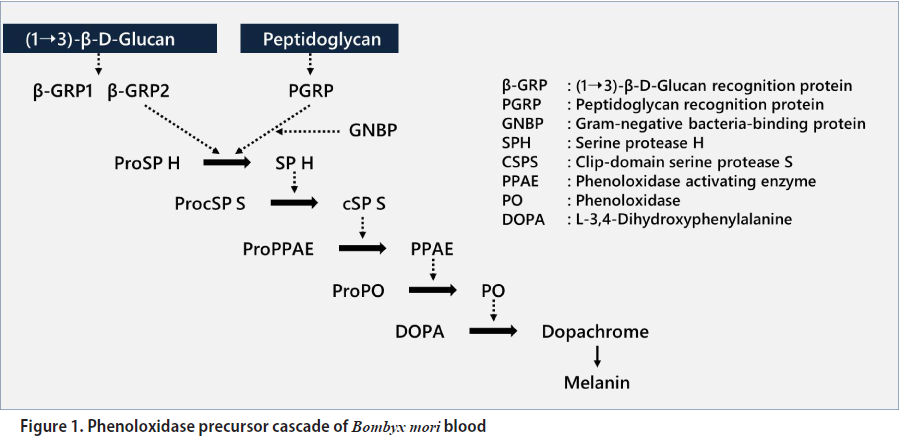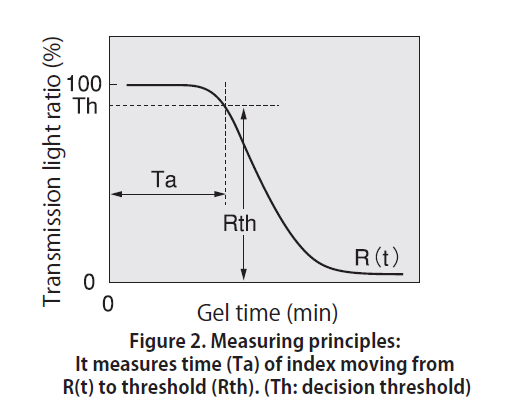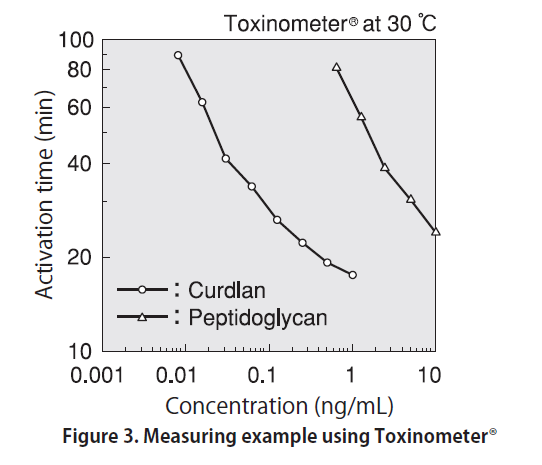SLP-HS Single Reagent Set Ⅱ
- Accurate and sensitive quantification of peptidoglycan(PG) and β-glucan with tube reader (Toxinometer®)
- Sensitivity: 10 pg/mL (PG), 1 pg/mL (β-glucan) (detected within 120 minutes with Toxinometer® at 30℃)
Kit Contents
| SLP-HS Reagent Ⅱ(Lyophilized reagent containing Silkworm Larvae Plasma and DOPA) | 0.1 mL x 20 vials |
| SLP diluent | 5.0 mL x 2 vials |
| Standard (digested peptidoglycan from Staphylococcus aureus) | 0.5 mL x 1 vial |
Principle
The hemolymph of the silkworm Bombyx moriI contains a self-defense mechanism termed the "prophenoloxidase (proPO) activating system" or "proPO cascade". Upon invasion of microbe such as bacteria and fungi, the system participates in melanin formation observed in the body fluid of insects to protect them from the in invader's attack. The system is triggered by peptidoglycan (PG) from bacteria and (1→3)-β-D-glucan (β-glucan) from fungi and yeast, and yeast, and consequently, proPO in the system is activated.
The system is thought to be a cascade reaction involving activation of multiple zymogens of proteinases.
The SLP (Silkworm Larvae Plasma) reagent is a lyophilized product containing factors of the proPO cascade, it is prepared from silkworm larvae body fluid and processed without melanin formation. The SLP reagent is activated by PG and/or β-glucan, then L-3,4-dihydroxyphenylalanine(DOPA) is oxidized and melanin is formed. Since PG is found on the cell wall of most bacteria and β-glucan is a component found in cell walls of many fungi, it is possible to detect various microorganisms by using melanin pigment formation of SLP reagent as an index.

Since PG is found not only in gram-positive but also gram-negative bacteria, the SLP reagent responds to a wide range of bacteria, regardless of their gram-staining classification. It also reacts with fungus-derived β-glucan, which suggests that it can respond widely to general microorganisms. Therefore, the concurrent use of LAL and SLP reagents, which are activated by endotoxin and β-glucan respectively, enable the type of microorganism in a sample to be predicted.
Applications
- Study of the structure-activity relationship, biosynthesis, metabolism and etiological significance of PG
- Investigation of water pollution
- Microbial contamination testing of the dialysate
- Detection for fungal compounds in pharmaceuticals and medical devices, biologics and genetically-engineered products
- Elucidation of the biological defense mechanism of insects
Measurement Method
PG and β-glucan can be detected using SLP-HS Single Reagent Set and an instrument of Toxinometer.
The measurement principle is the same with endotoxin detection method using Toxinometer (Figure 2).
The absorbance change (melanin production) generated by the activation are detected using Toxinometer.
The correlation between the PG(or β-glucan) concentration and Ta is obtained (Figure 3), and the PG (or β-glucan) concentration is calculated from Ta of each sample.
Wako Blog: Talking of LAL
For research use or further manufacturing use only. Not for use in diagnostic procedures.
Product content may differ from the actual image due to minor specification changes etc.
If the revision of product standards and packaging standards has been made, there is a case where the actual product specifications and images are different.






